

|
| ÖSTERREICH | AUSTRIA |
| Bundesland: Oberösterreich | Upper Austria |
| Bezirk: Steyr-Land |
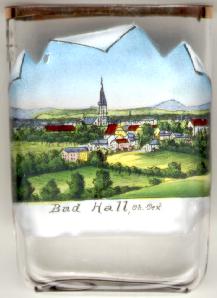
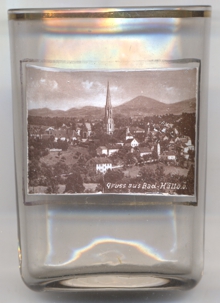 The name of Bad Hall is derived from the Thracian word hal for salt.
It was already used both for the place and the saline springs by the Illyrians who
settled in this area around 1100 BC. Around 400 BC the area was inhabited by Celts.
The Celtic kingdom of Noricum (2nd century BC) was conquered by the Romans in 16/15 BC
Coins from the time of Emperor Antoninus Pius (138-161 AD) prove the utilization
of the saline by the Romans. In 777 Duke Tassilo III of Bavaria gave the area and the springs to the
newly founded monastery of Kremsmünster.
Kremsmünster and other monasteries used the saline to meet their demand of salt until the 13th century.
After the closure of the salterns, the water was still used by the local people
as medicine for the treatment of goitres and chronic inflammations. Water and 'goitre bread'
of Hall even were sold in Styria (where goitres were endemic due to iodine deficiency).
Hall became a market town prior to 1230.
The name of Bad Hall is derived from the Thracian word hal for salt.
It was already used both for the place and the saline springs by the Illyrians who
settled in this area around 1100 BC. Around 400 BC the area was inhabited by Celts.
The Celtic kingdom of Noricum (2nd century BC) was conquered by the Romans in 16/15 BC
Coins from the time of Emperor Antoninus Pius (138-161 AD) prove the utilization
of the saline by the Romans. In 777 Duke Tassilo III of Bavaria gave the area and the springs to the
newly founded monastery of Kremsmünster.
Kremsmünster and other monasteries used the saline to meet their demand of salt until the 13th century.
After the closure of the salterns, the water was still used by the local people
as medicine for the treatment of goitres and chronic inflammations. Water and 'goitre bread'
of Hall even were sold in Styria (where goitres were endemic due to iodine deficiency).
Hall became a market town prior to 1230.
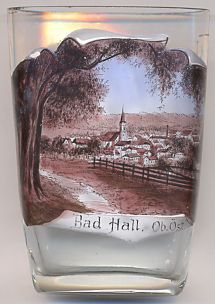 The development of Hall as a health resort began in the 19th century when the iodine content
of the water was discovered. At first only privately owned baths existed. However,
the spa only became successful when it was taken over by the provincial government in 1855.
The predicate 'Bad' was granted in 1876.
The development of Hall as a health resort began in the 19th century when the iodine content
of the water was discovered. At first only privately owned baths existed. However,
the spa only became successful when it was taken over by the provincial government in 1855.
The predicate 'Bad' was granted in 1876.
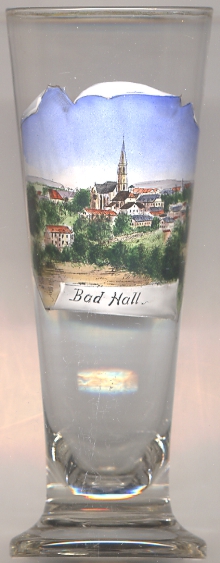
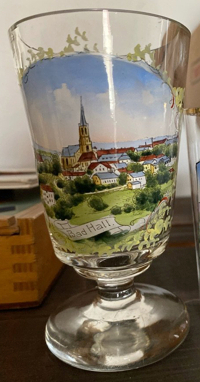
The  Catholic parish church zum Heiligen Erlöser (Holy Saviour)
[left, no. 2811, and right, no. 4807: background]
was built in 1869–1888 in Gothic revival style by the architect Otto Schirmer. Its spire has a height of 60 metres.
A century later, in 1985–1988, the church was renovated because the spire was in danger of collapsing
due to its weak foundations.
[http://www.bergfex.at/sommer/bad-hall/highlights/5423-kath-stadtpfarrkirche/]
Catholic parish church zum Heiligen Erlöser (Holy Saviour)
[left, no. 2811, and right, no. 4807: background]
was built in 1869–1888 in Gothic revival style by the architect Otto Schirmer. Its spire has a height of 60 metres.
A century later, in 1985–1988, the church was renovated because the spire was in danger of collapsing
due to its weak foundations.
[http://www.bergfex.at/sommer/bad-hall/highlights/5423-kath-stadtpfarrkirche/]
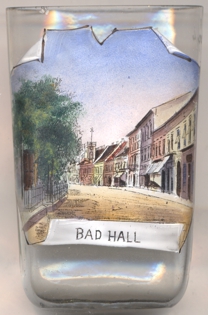
The picture on glass no. 4207 [near left] shows a view of the
 main square (Hauptplatz)
main square (Hauptplatz) Town hall
Town hall
[https://de.wikipedia.org/wiki/Liste_der_denkmalgesch%C3%BCtzten_Objekte_in_Bad_Hall,
https://docplayer.org/166509944-Informationen-sehenswuerdigkeiten-gastronomie-veranstaltungen-im-gaestezentrum-bad-hall-von-august-bis-november-2019.html]
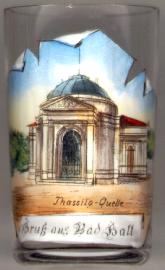
The  Thassilo-Quelltempel [left]
enclosing the old saline spring was erected in 1855.
Thassilo-Quelltempel [left]
enclosing the old saline spring was erected in 1855.
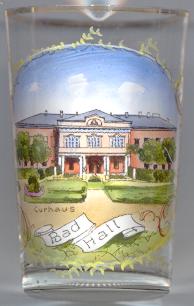
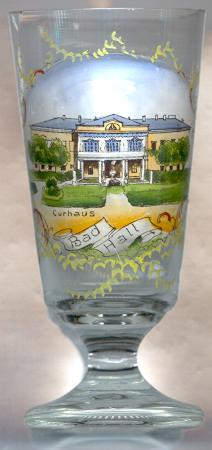
Centre of the resort was the  Kurhaus [right],
which was erected in 1853–1855 in Neoclassicist style.
Kurhaus [right],
which was erected in 1853–1855 in Neoclassicist style.
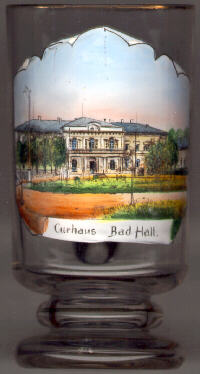
![[scale]](lineal.jpg)